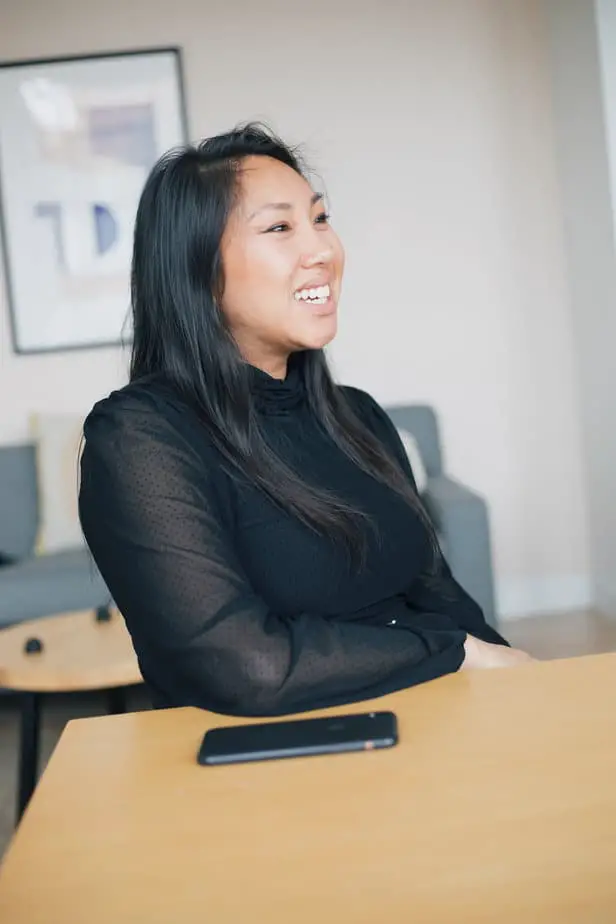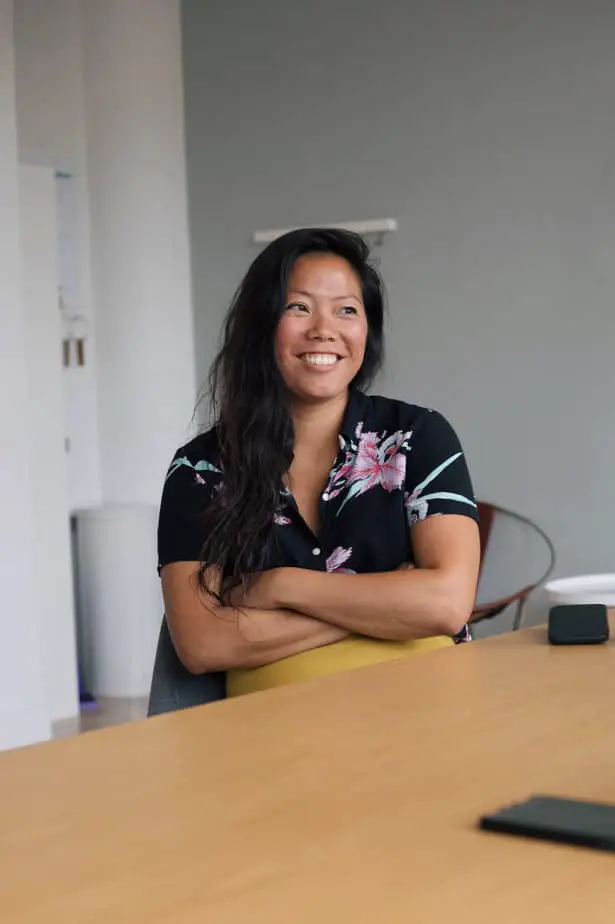Grass x Grass is a collective of four San Franciscans looking to erase the stigma around cannabis in the Asian American community. Born as the passion project of Courtney, Grace, Blake and Hubert, they recently celebrated the launch of their first video at a sold-out event that, among other things, involved Traditional Chinese Medicine, an ikebana workshop, and an ASMR Mukbang recording space. Describing themselves as relatively grassroots (pun intended), the collective is finding its feet amidst popularity and praise from the Asian American cannabis community and beyond. Hubert puts it simply: “we’re all trying to put together something and see if it sticks. And it has stuck.”
Ultimately, the platform aims to tell the stories of Asian Americans in cannabis. The collective steps up and fills a gap; according to Courtney, “there are a lot of narratives around the black and Latino experience, and then the white experience. But we are part of this cannabis industry, and no one’s really talking about us.”
If you’re looking for a quick introduction to who they are and what they do, I recommend that you watch Grass x Grass’ debut video. It’s a candid, funny conversation over a meal, shared between four industry professionals. This first installment features Monica Lo of Sousweed, Geraldine Mae Cueva of Art and Times of Chill, Jordan Lam of Permanent Holiday, and Haejin Chun of Big Bad Wolf. They’re all Asian Americans, and all innovators in the cannabis industry.
“I think [the video] is showcasing that a community already exists, so that people feel comfortable to be a part of the community,” says Courtney. This video sets the precedent for one of Grass x Grass’ main goals: to present real stories that show everyone else that a whole world of possibilities lies within cannabis. Each person featured in the video shares their personal history with the herb, their stories about the stigma, and their special niche within the industry. Grass x Grass is just that—a platform for sharing stories and starting conversations.
Navigating the Stigma
Grass x Grass is not alone in their cause (another organization with a similar goal is Asian Americans for Cannabis Education), and San Francisco boasts a strong Asian American presence in cannabis as well as a commitment to developing an inclusive cannabis industry. Yet, as our conversation continued, it became clear to me how widespread, intersectional, deeply-seeded this stigma is. My inner cynic nagged. Almost impossible to eradicate, no?
Grass x Grass’ model aims to reach the younger generation, and through them, their parents, aunts, uncles, and grandparents. The individuals of Grass x Grass know the cultural framework of Asian American households firsthand, and they understand the importance of educating the older generation with cultural sensitivity in mind. It all starts with the videos and events, which provide content and community to the generation that, although touched by a long-standing cultural stigma, takes a more moderate stance on the issue. To recap: it’s about empowering the younger generation to fully embrace the benefits of cannabis, and giving them the tools to open up this conversation with their parents and grandparents—essentially, trusting the framework of a multi-generational household in order to reach the older generation.
“For older generations, it’s actually really as simple as they’re in pain. That’s really what it comes down to. And that’s always been the opening conversation, especially with the availability of CBD now as well. And that actually helps to further the conversation with THC. It’s a slow onboarding process,” says Courtney.
The stigma is perhaps the most difficult issue to resolve, but accessibility is also a big problem when it comes to making cannabis available to all members of the Asian American community. The good old language barrier is one facet of this. Drawing parallels to issues with mainstream healthcare access, Courtney and Grace both pointed out the fact that a lack of appropriate educational resources is a weak spot. Most of the cannabis education out there is only available in English, which is an inhibiting factor for many people in the community, especially elderly folks. Another barrier is simply the nature of the dispensary. At one point or another in the past few years, the dispensary has been a new environment for all. Courtney aptly described that most experiences are never completely novel: when you walk into a bar for the first time, you’ve already seen various bar experiences through film and TV. On the other hand, “dispensaries are one hundred percent novel. People don’t know what questions to ask. They’re intimidated by going to the dispensary.”
The hope is that the younger generation will be able to access the necessary resources to help their older family and friends feel more comfortable and more informed. In the future, Grass x Grass aims to provide said support, whether that might mean translating resources or organizing dispensary tours.
A 10,000 Year History
Courtney was quick to point out that the stigma has not always existed within Asian communities. Out of the group, she was clearly the expert on this, as she talked impassionately about the history that often goes unseen (Blake pointed out that one of Courtney’s projects with her company, Amnesia Media, was to research the long history of cannabis in Ancient Asia). Archaeological evidence traces the oldest uses of the plant back to Taiwan, 10,000 years ago. According to Psychology Today, Emperor Shennong, born 2700 BCE, pioneered the use of cannabis as a medicinal plant, as well as laying the foundations for Traditional Chinese Medicine as we know it today. The ancient Chinese had complex knowledge about the herb, and cultivated the female plant because of its greater medicinal properties; hemp was even considered one of the five staple grains in Ancient China.
To the 20th Century
So how did all that change?
“When we talk about China specifically… we can’t discount colonialism and opium, right. That had a huge impact on how Chinese people perceived intoxication,” Courtney said.
1912 saw the first international efforts at drug control with the Hague International Opium Convention. Although cannabis was not discussed at that particular event, Courtney explained that modern drug protocol stemmed from that first convention. When cannabis was added to the status of “drug” alongside the likes of opium, heroin, and cocaine, the same rules applied to what was once known as a medicinal plant.
The war on drugs maintains a constant, ghostly hold on communities of color all over the country. There’s no doubt that black and Latinx communities were hit hardest by its policies. Blake brought up the immigration narrative around drugs that sprang up as a result of the war on drugs: that foreigners brought marijuana from across the Mexican border.
“I think, unfortunately, Asian Americans possibly internalized the racialized messages that came from the war on drugs. The Nixon administration… forced this idea that foreigners brought in marijuana, that it was this Mexican drug… For Asian Americans, I think some of the reasons that they distanced themselves from it… is because… they wanted to separate themselves from those kinds of very derogatory, very negative imagery of those other communities,” said Courtney.
Blake pointed out the statistics, “It’s a narrative that continues to this day. 90% of our imported illegal drugs come through our major ports… they don’t come over our borders, which is the narrative that we’re being fed by our current administration… And that’s just the imported drugs, not drugs made domestically.”
Grass x Grass recognizes the importance of engaging with this complex intersectional stigma. Courtney, for one, has volunteered with Bay Area equity programming in the past. According to the San Francisco City Equity Report, equity programs exist to ensure that the individuals hit hardest by the war on drugs will also have an equal chance of thriving in the cannabis industry.
Courtney added, “and we, to some extent, have to address that cannabis is for everyone, and to take away the message that the war on drugs forced them to internalize.”
Although the goals of the Grass x Grass platform may overlap with equity program-style activism, the collective prefers to call their work advocacy, rather than activism. As Blake put it, “I don’t think we’re trying to disrupt the turnover system as much as advocating for people and letting other people’s voices be heard in this narrative that maybe haven’t been heard before.”
Now, Grass x Grass is still in the process of reflecting on the successes of the past few weeks and planning their next moves. Although their next steps are not yet set in stone, they’re all confident in their ethos as they move forward. Grass x Grass will continue to be a platform to consolidate and work with the community, and of course, to amplify the stories of Asian Americans in cannabis. One thing for certain is that there are many, many more stories to be told, all that build up to create the varied experiences that Asian Americans have with cannabis. And Grass x Grass will be telling them.
// Check out more of the Grass x Grass content here and never miss one of their events; photography by Alec White.

